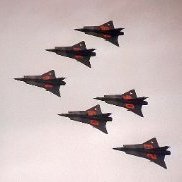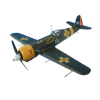-
Posts
4,146 -
Joined
-
Last visited
About alt-92

Profile Information
-
Gender
Male
-
Location
NL
-
Interests
Plane nuts (and bolts).
Gen-X, amateur historian.
Recent Profile Visitors
8,359 profile views
alt-92's Achievements

Very Obsessed Member (5/9)
9.1k
Reputation
-
Correct. Note that they also mention the exact tree letters that are in the kit. Looks like it's actually minor surgery, apart from the changes in panels for the bottom cowling. 70171x (D-5) fuselage tree: You probably need to make a small cut and trim away some of the fuselage to allow for the fillet to blend in the fuselage. The cut is present on the 70172x (D-10+) fuselage tree:
-
Looks like PlusModel is getting more sales of their cowling set...
-
(510x640)-Copy(95x120).thumb.jpg.33073138e01aa81779639a845926753e.jpg)
Ju 88 G-6 with spurious US-markings - are there any decals?
alt-92 replied to Stickleback's topic in Aircraft WWII
If that's the pictures with a truck or motorvehicle on the right hand side, those might be the pics taken in August 1945, after the captured aircraft were shipped to Wright Field. -
(510x640)-Copy(95x120).thumb.jpg.33073138e01aa81779639a845926753e.jpg)
Saunders-Roe SR.45 Princess - Arsenal Model Group 1/350.
alt-92 replied to Alain76's topic in Ready for Inspection - Aircraft
Great execution, the darker panels look really nice. And the sea scape is a very good idea. Haven't gotten mine to the paint stage yet, but it's a nice size model actually - about the size of a 1/72 Spit.- 21 replies
-
- 1
-

-
- Arsenal Model Group
- Saunders-Roe SR.45
-
(and 1 more)
Tagged with:
-
Cutting Edge does them under Pyn-up. I gather the owner is not everyone's favourite, but the decals are really good.
- 23 replies
-
- 2
-

-
- P-51B
- P-39 Airacobra
-
(and 1 more)
Tagged with:
-
F-5C decals: F-5B decals - pic is a bit blurry on the edges, it's not the decal sheet. Now all we need is someone re-issue the decals for Lanakila, the only ones I've ever seen are an older AeroMaster set.
-
There was a significant amount of radio interference in the SWP in 1942-1943, possibly related to the relative high sunspot activity from the early 1940s that was greater than previous episodes. Somewhere in my library there's a map with the worst spots, right over the NEI and New Guinea area in that time. So not only would you have the 'normal' weather to contend with, but also the geomagnetic results from sunstorms like we had a bit more than a week ago.
-
What it does do however is show the Sto-Wing action, and the F6F pic emphasises the point that it would be a very exceptional situation for the rockets to be attached with wings folded - the lack of space and position on the wing fold makes it less than practical to put it mildly.
-
I keep mixing up the 1/72 and 1/48 kits.
-
Well, it does say Seafire III on the box, not Ib.
-
There's ways to tell. Back in the very early 1980s, my dad was looking for a new Peugeot 304 Break (as a shop owner, the stationwagon allowed for doing deliveries). The car the dealer offered must have tumbled off the production line somewhere as it was 1.5" shorter on one side - the tell was the gaps between the panels & rear door. That's not something you can fix with a bit of sanding though Needless to say, that one was rejected and another brought in via the importer.
-
I was under the impression that the 04100-1 is the original, and A02040 is that kit with an extra tree containing the Vc & seafire bits.











